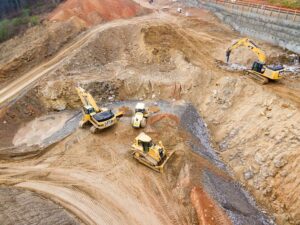Complete Guide to Kentucky Erosion Control Permits & Regulations
Kentucky construction projects face rigorous erosion control regulations designed to protect waterways, prevent sediment pollution and ensure legal compliance. Understanding Kentucky’s erosion control regulations is essential for general contractors, builders and civil works project managers to avoid fines, project delays and environmental damage. This guide delivers clear definitions of key statutes, step-by-step permit instructions, and best management practices (BMPs) for on-site sediment control. You will learn:
- The federal, state and local erosion control regulations that apply in Kentucky
- How to secure and manage a Kentucky KPDES stormwater permit
- The components and maintenance of an effective Stormwater Pollution Prevention Plan (SWPPP)
- Practical BMPs for temporary and permanent erosion control
- Local MS4 land disturbance permit requirements
- When USACE Section 401 and 404 permits are required
- Strategies for full compliance and how Earth Works, LLC supports your project from permits to on-site implementation
This comprehensive overview of erosion control regulations in Kentucky establishes the foundation for every subsequent regulatory and practical section, unifying federal law, state-issued permits and local requirements under one cohesive framework.
What Are the Key Erosion Control Regulations for Construction Projects in Kentucky?
Kentucky’s erosion control regulations require that any land-disturbing activity disturbing one acre or more—or part of a larger common plan of development—obtain appropriate stormwater permits, implement BMPs and maintain an approved SWPPP to minimise sediment runoff. This legal framework originates from the federal Clean Water Act, is administered by the Kentucky Division of Water under KPDES, and is reinforced by local MS4 ordinances in many municipalities. Applying these regulations protects water quality, reduces legal risk and promotes sustainable site development.
Which Federal, State, and Local Laws Govern Erosion Control in Kentucky?
Kentucky construction sites are subject to:
- The federal Clean Water Act (33 U.S.C. §1251 et seq.) governing discharges to waters of the United States
- Kentucky Pollutant Discharge Elimination System (KPDES) regulations (401 KAR Chapter 5) administered by the Kentucky Division of Water
- Municipal Separate Storm Sewer System (MS4) ordinances enacted by local jurisdictions such as Louisville MSD or Bowling Green
These layers of regulation intertwine to ensure consistent sediment control across all levels of jurisdiction and prevent unchecked stormwater pollution.
Kentucky Environmental Law Handbook: Compliance and Regulations
Authored by a preeminent national environmental law firm, this handbook offers clear, accessible explanations of state compliance duties. It provides comprehensive coverage of hazardous and solid waste disposal; air, water, and natural resources regulations; the state’s organisational structure; requisite permits and reports; the interplay between federal and state regulations; and more.
KENTUCKY
How Does the Clean Water Act Impact Kentucky Construction Sites?
The Clean Water Act mandates that point-source discharges—including stormwater runoff from large construction sites—must be permitted. Section 402 requires KPDES coverage for discharges associated with land disturbance over one acre, while Section 404 governs dredge-and-fill activities in wetlands and waterways, enforced by the US Army Corps of Engineers. Compliance with these sections safeguards stream and river health and is the basis for state and local permit programs.
What Roles Do the Kentucky Division of Water and Local MS4s Play?
The Kentucky Division of Water reviews KPDES permit applications, issues KYR10 general permits for stormwater, and conducts inspections to verify SWPPP implementation. Local MS4 authorities—such as metropolitan sewer districts and county governments—often impose additional erosion control standards, inspection routines and local land disturbance permits to address urban runoff and infrastructure constraints. Together, these agencies form a comprehensive oversight network.
Why Is Compliance Critical to Avoid Fines and Project Delays?
Non-compliance can trigger administrative penalties, stop-work orders and costly remediation requirements. Regulatory authorities may assess fines of several thousand dollars per violation, and construction schedules often stall until corrective measures are approved. Proactive erosion control planning and permit management protect project timelines and budgets.
Who Needs a Kentucky KPDES Stormwater Permit and How Is It Obtained?
Any construction activity disturbing one acre or more—or less if part of a larger development—must secure KPDES stormwater coverage. The KYR10 general permit streamlines authorisation for common construction scenarios, requiring an electronic Notice of Intent (eNOI) and an approved SWPPP.
What Is the KYR10 General Permit and Who Must Apply?
The KYR10 general permit provides standardised stormwater discharge authorisation for sites disturbing at least one acre of land. It covers earthwork, grading, excavation and other activities that expose soils to precipitation. Developers, contractors and landowners must apply if their project meets or exceeds the one-acre threshold or is part of a phased common plan.
How Do You Complete the KPDES eNOI Application Process?
- Prepare project details including site maps, anticipated acreage and receiving waters
- Complete the Kentucky eNOI form online with the Division of Water portal
- Attach a draft SWPPP outlining proposed BMPs and inspection schedules
- Pay the permit fee as required by state regulations
- Receive confirmation of coverage and KPDES permit number
Filing an accurate eNOI initiates legal authorisation for stormwater discharges under KYR10.
When and How Should You File a Notice of Termination (NOT)?
Once final stabilization is achieved—typically when all disturbed areas are permanently vegetated or paved—a Notice of Termination must be submitted to formally end permit coverage. The eNOT process involves verifying that BMPs have been correctly closed out and post-construction inspections confirm no active erosion risk remains.
What Are Common Compliance Requirements and Enforcement Actions?
- Regular site inspections by qualified personnel
- Accurate logbooks of inspection dates and findings
- Prompt repair or replacement of BMPs that fail performance standards
Enforcement may include on-site audits, non-compliance notices and monetary penalties. Consistent record-keeping demonstrates due diligence and mitigates enforcement risk.
How Can Earth Works, LLC Assist with KPDES Permit Applications?
Earth Works, LLC offers end-to-end KPDES support, from eNOI preparation and SWPPP development to routine site inspections and NOT filings. Leveraging deep knowledge of Kentucky-specific regulations, we ensure accurate applications, reliable BMP design and ongoing compliance monitoring to protect your project timeline and budget.
How Do You Develop and Implement a Stormwater Pollution Prevention Plan (SWPPP) in Kentucky?
A SWPPP is a site-specific document that identifies potential pollutant sources and prescribes BMPs, inspection schedules and maintenance procedures to prevent sediment discharges. Developing a robust SWPPP underpins KPDES permit compliance and minimises environmental impact.
What Are the Essential Components of a Kentucky SWPPP?
- A detailed site map showing disturbance limits, drainage patterns and receiving waters
- A description of temporary and permanent BMPs, such as silt fences and sediment basins
- An inspection and maintenance schedule with qualified personnel assignments
- Contact information for the responsible site operator and permit holder
This comprehensive plan clarifies responsibilities and ensures transparent erosion control implementation.
How Do Best Management Practices (BMPs) Integrate into SWPPP?
BMPs are the mechanisms through which the SWPPP achieves sediment retention and runoff control. Temporary measures—such as filter socks, stabilized entrances and turbidity curtains—address active disturbance zones. Permanent practices—like re-vegetation, erosion control blankets and retention basins—secure long-term site stability and water quality protection.
What Are Common Pitfalls in SWPPP Preparation and How to Avoid Them?
- Model peak storm events to select correctly sized BMPs
- Incorporate contingency measures for unexpected erosion hotspots
- Train on-site staff in inspection standards and maintenance protocols
Proactive SWPPP refinement prevents costly corrective actions.
How Is SWPPP Maintenance and Inspection Managed During Construction?
Qualified personnel must perform inspections at least once every seven days and within 24 hours of rainfall events exceeding 0.5 inches. Inspection reports should document BMP condition, corrective actions taken and dates of implementation. This ongoing vigilance ensures sediment controls remain effective from groundbreaking through final stabilization.
What Are the Best Management Practices (BMPs) for Erosion and Sediment Control in Kentucky?
Implementing targeted BMPs reduces sediment loads entering waterways and supports sustainable site development. Integrating both temporary and permanent measures yields optimal erosion prevention.
Which Temporary BMPs Are Most Effective on Construction Sites?
- Silt fences to intercept sheet flow and trap suspended sediment
- Sediment traps or check dams in drainage channels to slow runoff velocities
- Stabilized construction entrances to remove sediment from vehicle tires
These measures prevent sediment migration during active land disturbance and support compliance with permit requirements.
What Permanent BMPs Support Long-Term Erosion Prevention?
By combining vegetation and engineered structures, permanent BMPs sustain site integrity and water quality over time.
How Should BMPs Be Maintained and Inspected for Compliance?
Routine maintenance includes repairing damaged fences, dewatering filled sediment traps and re-seeding bare areas. Documentation of these activities in the SWPPP inspection log demonstrates ongoing due diligence and protects against enforcement actions.
How Do BMPs Reduce Sediment Runoff and Protect Kentucky Waterways?
BMPs function by reducing flow velocities, filtering suspended solids and trapping sediment on-site. This process preserves water clarity, supports aquatic habitat health and aligns with state and federal water quality objectives.
What Local Erosion Control Ordinances and Land Disturbance Permits Apply in Kentucky MS4 Jurisdictions?
In designated MS4 areas, municipalities impose additional land disturbance permit requirements to supplement state KPDES permits. These local ordinances often stipulate tighter thresholds, design standards and inspection protocols.
Which Cities and Counties Have Specific Erosion Control Requirements?
- Louisville MSD, requiring a separate EPSC permit and quarterly inspections
- Bowling Green, enforcing enhanced silt fence and inlet protection standards
- Frankfort, with a one-acre threshold for local land disturbance permits
Developers must verify local requirements early to integrate them into project budgets and schedules.
How Do Local Land Disturbance Permits Differ from State KPDES Permits?
- Apply to smaller disturbance areas than one acre
- Mandate more frequent or detailed site inspections
- Require application fees and escrow deposits for inspection compliance
Understanding these differences ensures that both local and state authorisations are secured before site work begins.
What Are the Steps to Obtain Local Land Disturbance Permits?
- Review municipal ordinance and threshold criteria
- Submit site plans, drainage analysis and BMP details to local stormwater authority
- Pay application and inspection fees
- Schedule pre-construction meetings and inspections as required
Timely permit acquisition prevents construction holds and aligns local agency expectations.
Why Is It Important to Verify Local MS4 Ordinances Before Starting Construction?
Local MS4 authorities can impose stop-work orders for unpermitted land disturbance. Early ordinance review avoids costly project interruptions, ensures community water quality protection and demonstrates responsible site stewardship.
When Are US Army Corps of Engineers (USACE) Permits Required for Kentucky Waterway Projects?
USACE clean water permits under Sections 404 and 401 are mandatory when construction activities impact streams, wetlands or other waters of the United States. These federal authorisations complement state and local erosion control requirements.
What Are Section 404 and Section 401 Permits Under the Clean Water Act?
Section 404 permits regulate the discharge of dredged or fill material into waters, including wetlands, while Section 401 water quality certifications ensure state water quality standards are met for federally permitted discharges. Both work together to protect aquatic resources.
How Do You Determine If Your Project Impacts Waters of the United States?
- Presence of perennial or intermittent streams on site
- Wetland boundaries mapped by the USACE or National Wetlands Inventory
- Connectivity of onsite waters to downstream federal waterways
This evaluation guides permit strategy and project design modifications.
What Is the Application Process for USACE Permits in Kentucky?
- Submit a Pre-Construction Notification or permit application package to the local USACE district office
- Provide impact assessment, mitigation plans and site drawings
- Coordinate with state water quality authorities for Section 401 certification
- Address USACE comments and secure formal permit approval
Timely engagement with USACE prevents project delays caused by jurisdictional uncertainties.
How Do USACE Permits Complement KPDES and Local Requirements?
USACE permits focus on fill and dredge impacts, while KPDES regulates stormwater discharges and local MS4 ordinances cover broader runoff controls. Together these permits ensure comprehensive protection of water resources from both sediment and hydrologic alterations.
How Can Contractors and Builders Ensure Full Compliance with Kentucky Erosion Control Regulations?
Full compliance requires integrated planning, thorough documentation and ongoing site management. By combining expert guidance with proven methodologies, projects remain on schedule and aligned with all regulatory demands.
What Are the Common Challenges in Meeting Erosion Control Requirements?
Typical obstacles include underestimating BMP needs, incomplete SWPPP details and lapses in inspection documentation. Unanticipated rain events and phased construction can expose gaps in sediment control strategies.
How Does Proper Planning Mitigate Risks of Fines and Delays?
Developing a comprehensive SWPPP aligned with federal, state and local criteria before ground-breaking establishes clear BMP designs, inspection routines and corrective action protocols. This foresight prevents stop-work orders and ensures uninterrupted progress.
What Resources and Checklists Can Help Streamline Compliance?
Downloadable permit application checklists, SWPPP templates and BMP selection guides simplify preparation. On-site inspection forms and maintenance logs further ensure documentation accuracy and audit readiness.
How Does Earth Works, LLC Support Compliance from Permits to On-Site BMP Implementation?
Earth Works, LLC provides complete regulatory support—ranging from KPDES eNOI filings and SWPPP development to local permit negotiations, USACE consultations and hands-on BMP installation. By leveraging Kentucky-specific expertise, our team ensures efficient, cost-effective compliance that protects your project’s timeline and budget.
Your Kentucky construction project’s erosion control success starts with informed planning and expert execution. Contact Earth Works, LLC via kyearthworks.com or our Google Business Profile (g.co/kgs/NMCa9dZ) to secure regulatory compliance and protect your worksite from sediment pollution and costly delays.


